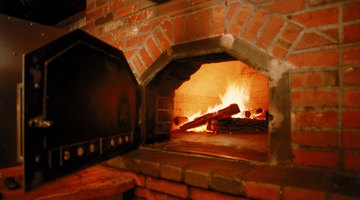Fire Brick Uses
Fire bricks are made from fire clay, which is a typical mud clay, that has a high alumina content. Fire clay has an extremely high melting point and so is used in many high-heat applications. Fire clay is normally light and whitish in color, and so too are fire bricks.

Kilns
Pottery kilns require very high temperatures to properly vitrify the clay and make it non-porous. Fire bricks are commonly employed as either the entire kiln structure, or for the inner layer of the kiln, where the most heat is present. Higher alumina content bricks (around 40 percent) are required for the inner surface of kilns that need to fire raku ware and stoneware, which reaches temperatures of 1,800 to 2,200 degrees Fahrenheit respectively. Soft fire bricks are often used to block up the kiln doors during firing, as they are less durable for permanent construction, and provide easily-removed insulation for the kiln door.
Fireplaces
Fireplaces often employ fire bricks in the inner fire box to insulate against heat damage to surrounding walls, and to keep the mantle and outer fire place relatively cooler. For fireplaces, fire bricks with alumina content of around 18 to 20 percent are sufficient.
Wood Fired Ovens
Wood-fired ovens, such as traditional pizza ovens, commonly use fire bricks in the inner construction around the oven chamber. Fire bricks are used in the cooking floor as well as the dome or roof of pizza ovens, and are able to withstand the thermal cycling (rapid heat up and cool down) that wood-fired ovens experience. Using fire bricks in wood-fired ovens makes the oven last a lot longer, and they can easily withstand the average 900 degrees Fahrenheit that these ovens reach.
Liners/Insulators
Fire bricks are used extensively as insulators and liners in all kinds of wood-fire heaters, small furnaces and even industrial-sized furnaces. Refractory bricks, as fire bricks are sometimes called, are used in blast furnaces because they have low thermal conductivity and insulate the heat from the furnace, providing the double benefit of making the furnace hotter and more efficient, as well as protecting the outside of the furnace from excess heat.
References
Writer Bio
B.T. Alo is media director, chief writer and editor for a U.S.-based marketing and consulting firm. He holds a bachelor's degree in business and communications. Alo's interests include business, investments, electronics, personal finance, health, communication, popular trends and travel.
Photo Credits
- Jupiterimages/Comstock/Getty Images
- Jupiterimages/Comstock/Getty Images
More Articles



